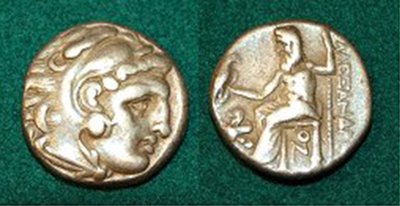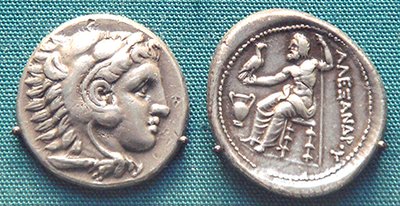This Will Not Affect The Drachma In Your Pocket
Friday, 15 April 2011By Nick Goddard
In 331 BC Alexander the Great captured the Persian city of Susa and with it a legendary treasury containing many tonnes of precious metals. In order to pay his army, Alexander minted enormous numbers of drachma coins from the silver captured at Susa, Damascus and elsewhere on his campaigns. On one side these showed Alexander as Heracles, a mortal son of Zeus who was granted immortality because of his amazing deeds. Alexander’s family had traced its lineage back to Heracles even before his conquests seemed to anoint him a true successor to the legendary hero. The other side shows Zeus holding a sceptre and eagle with the legend Alexandrou (‘of Alexander’). The coins minted from the Susa silver, and others of near identical design produced by Alexander's successors, set the standard for currency in the Hellenistic world and continued to circulate for at least 250 years after his death.
I have always been interested in coins, and when my son Alexander was born in 1991 I celebrated by treating myself to an Alexander drachma. Photos of my coin are shown below left, and right of that an image of a much better preserved specimen in the British Museum.


I am not sure exactly how much I paid for the coin, but seem to remember it was in the region of £25; today you might pay £50-100 on eBay. The sheer ubiquity of the Alexander drachmas means that they have almost no scarcity value despite their great antiquity. This set me wondering what the spending power of the coin might have been when it was minted. There is a learned tome written by Matthew Trundle on the subject of the wages earned by Greek soldiers called ‘Greek mercenaries: from the late archaic period to Alexander’. I have not studied Trundle’s treatise in detail, but get the impression that one drachma a day was good going, and nobody expected to be paid every day.
This would suggest a rough salary for a private soldier in Alexander’s army of, say, 250 drachmas per year. Today, those 250 coins would be worth about £20,000. This would pay the wages of a modern infantryman for a year. In other words, a bag of drachmas put aside 2,350 years ago has almost exactly the same purchasing power now as it did then. So who needs interest bearing savings accounts to guard against inflation?